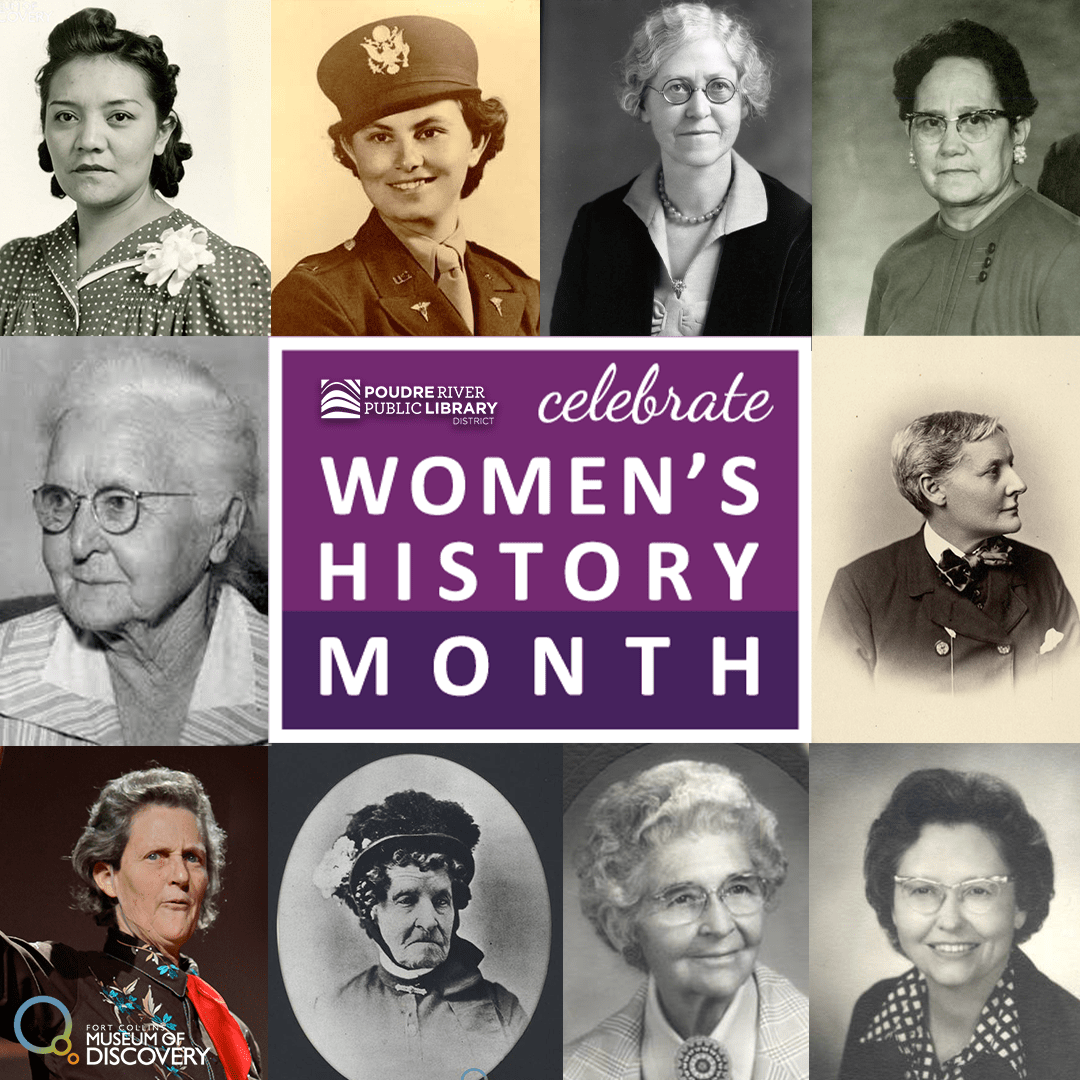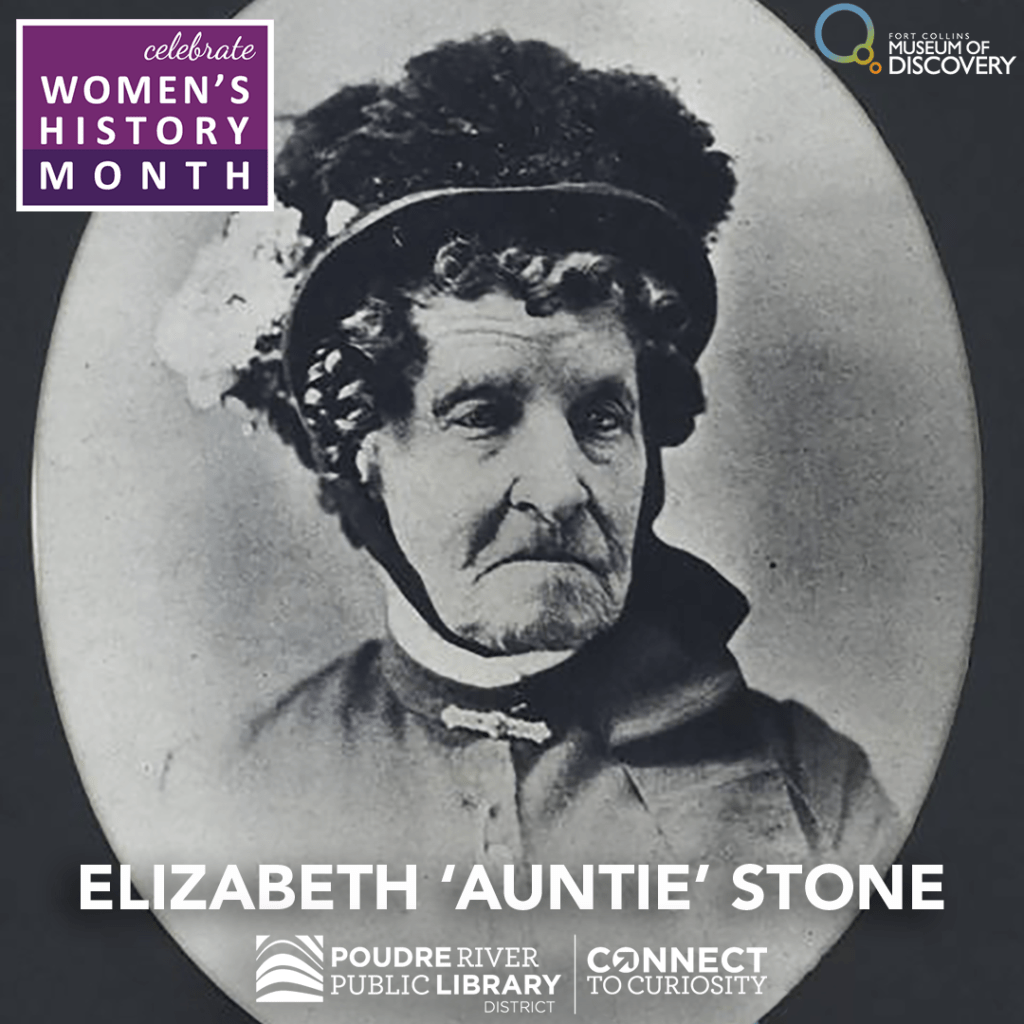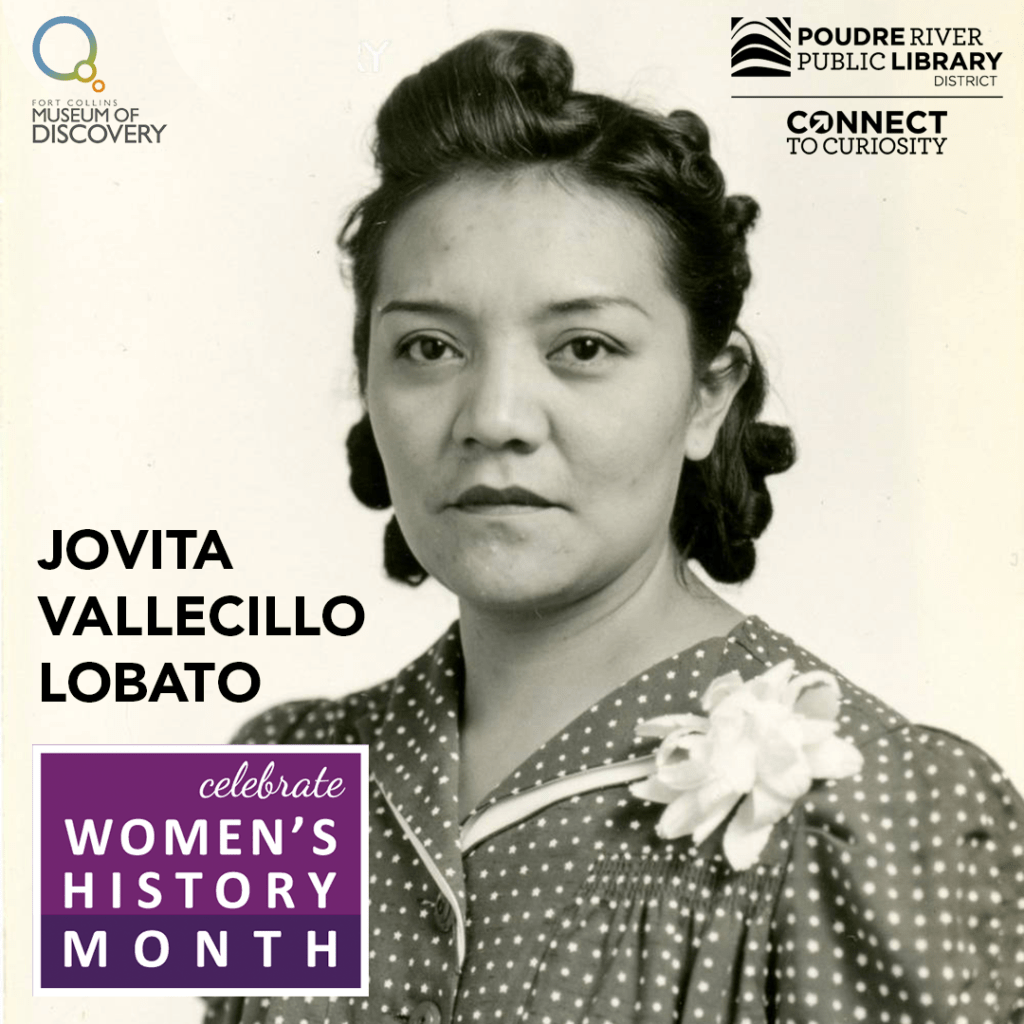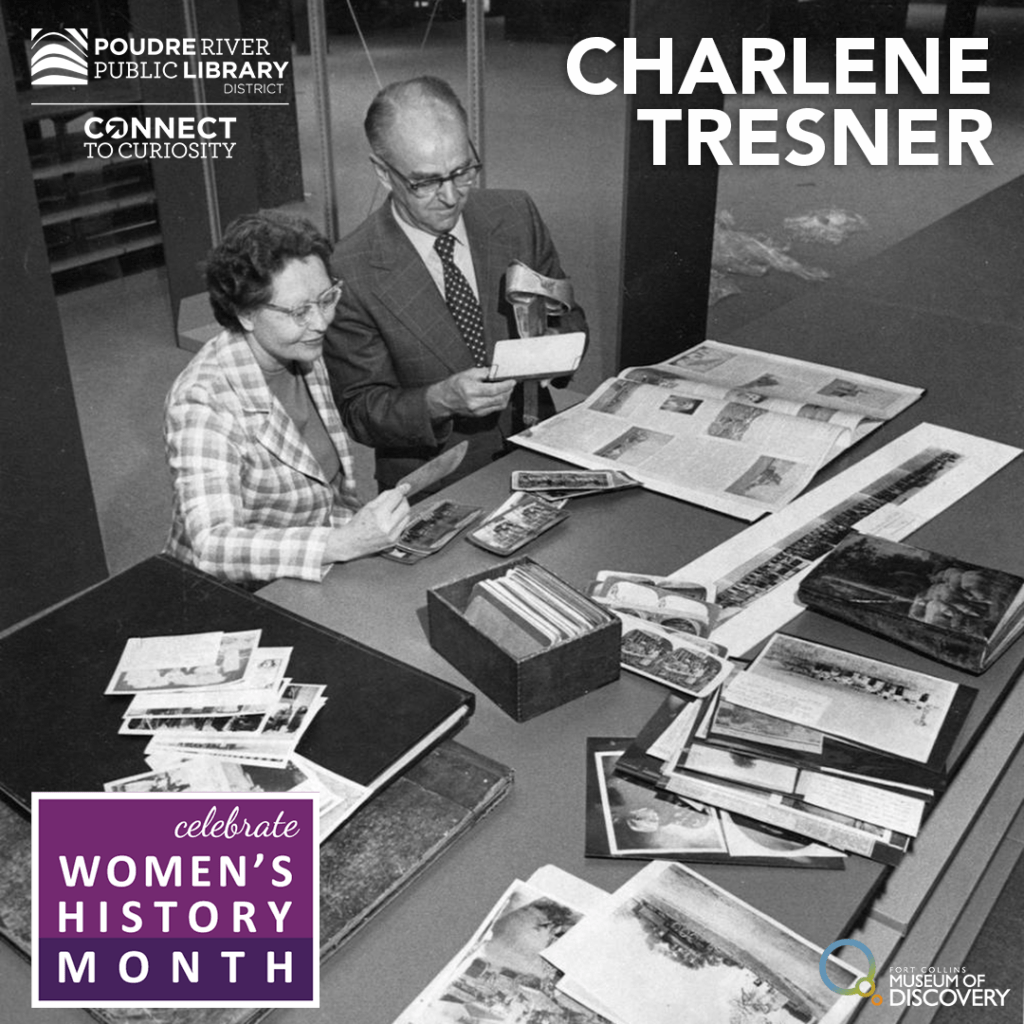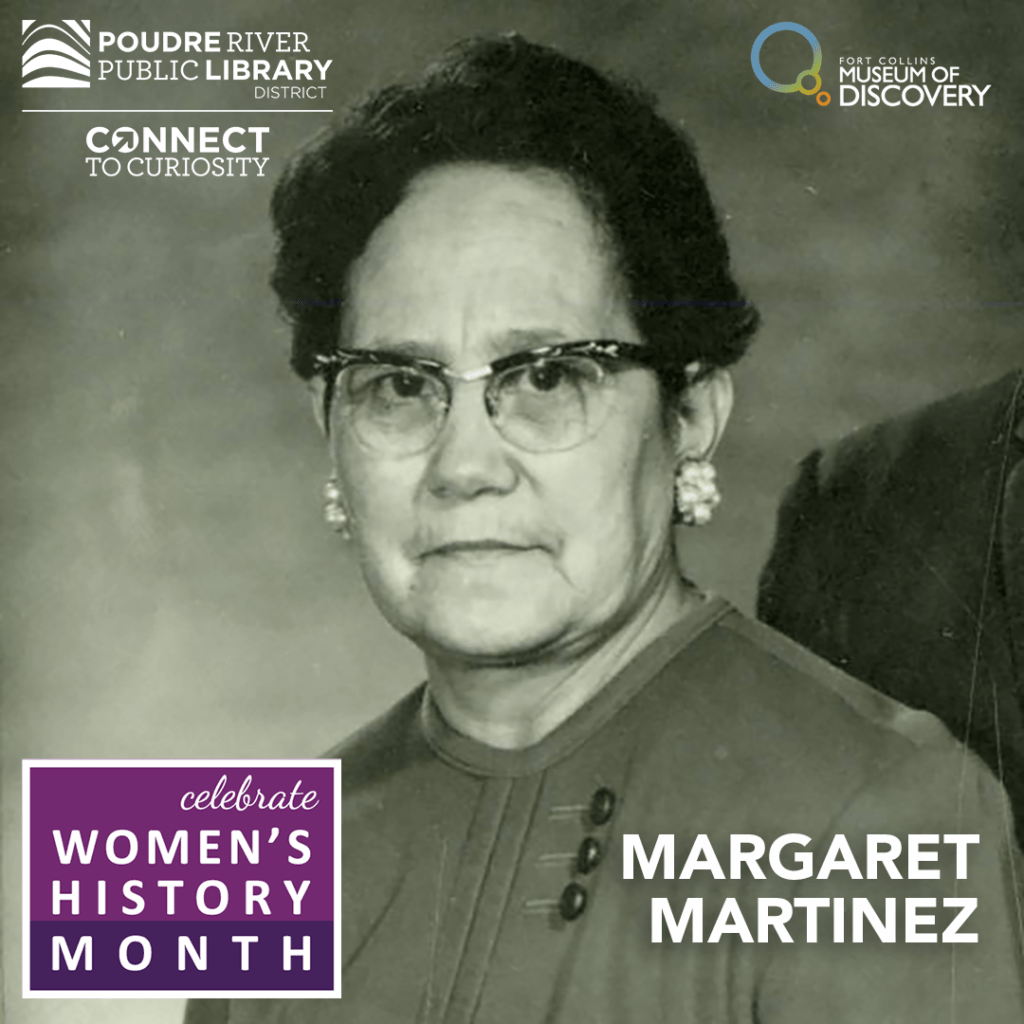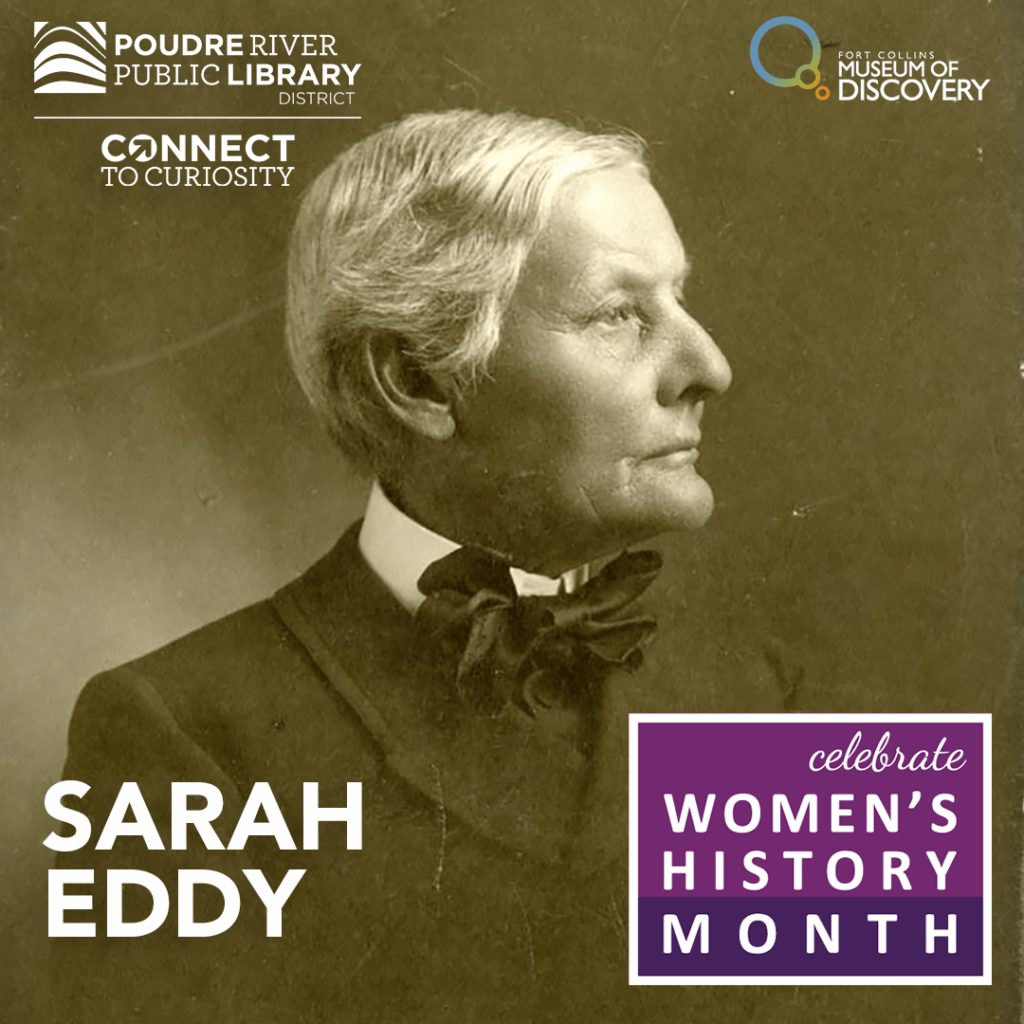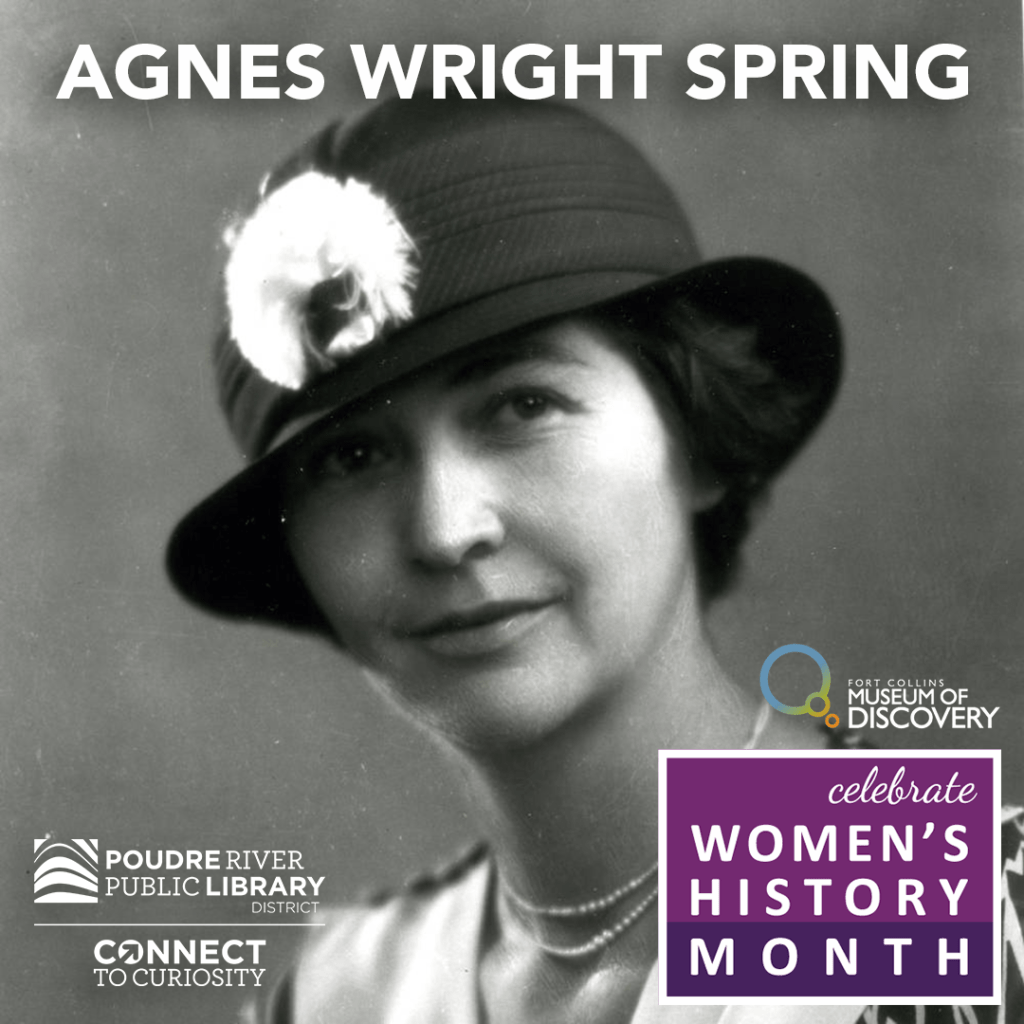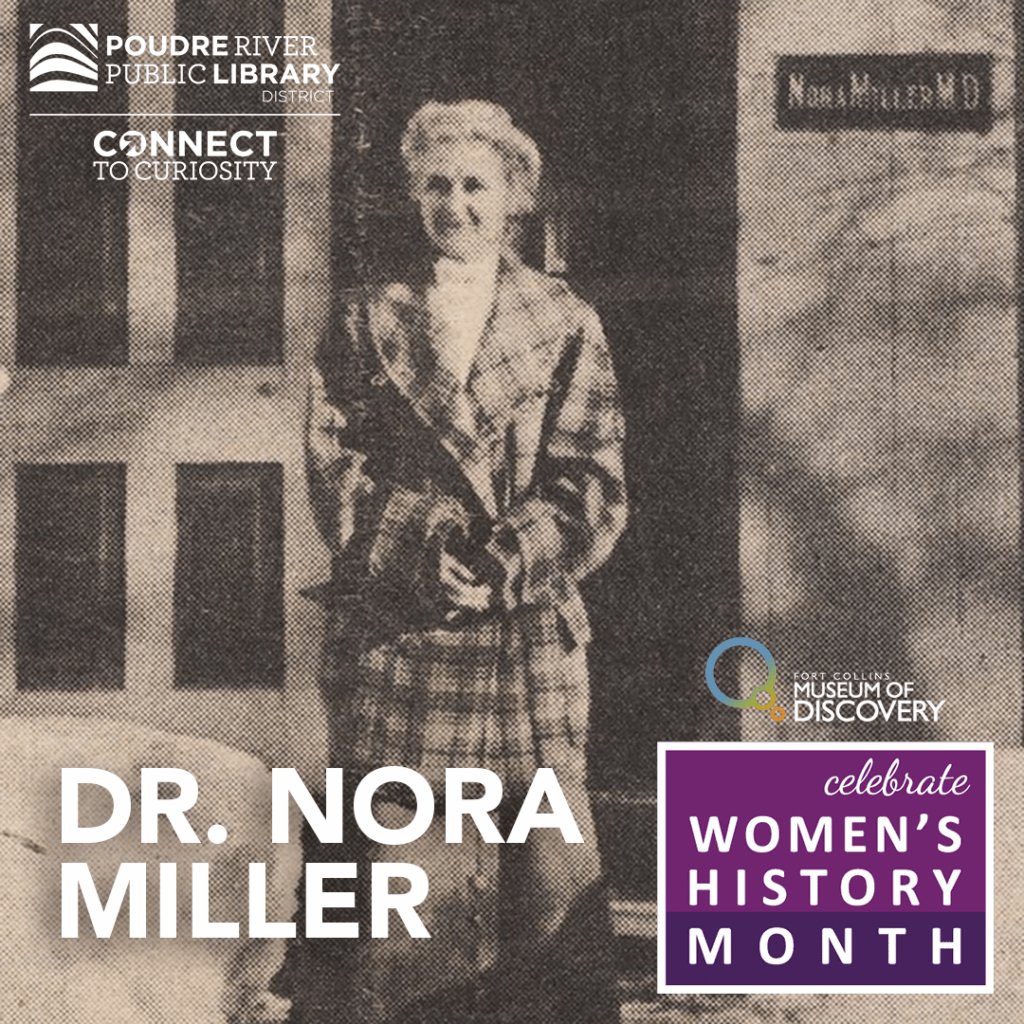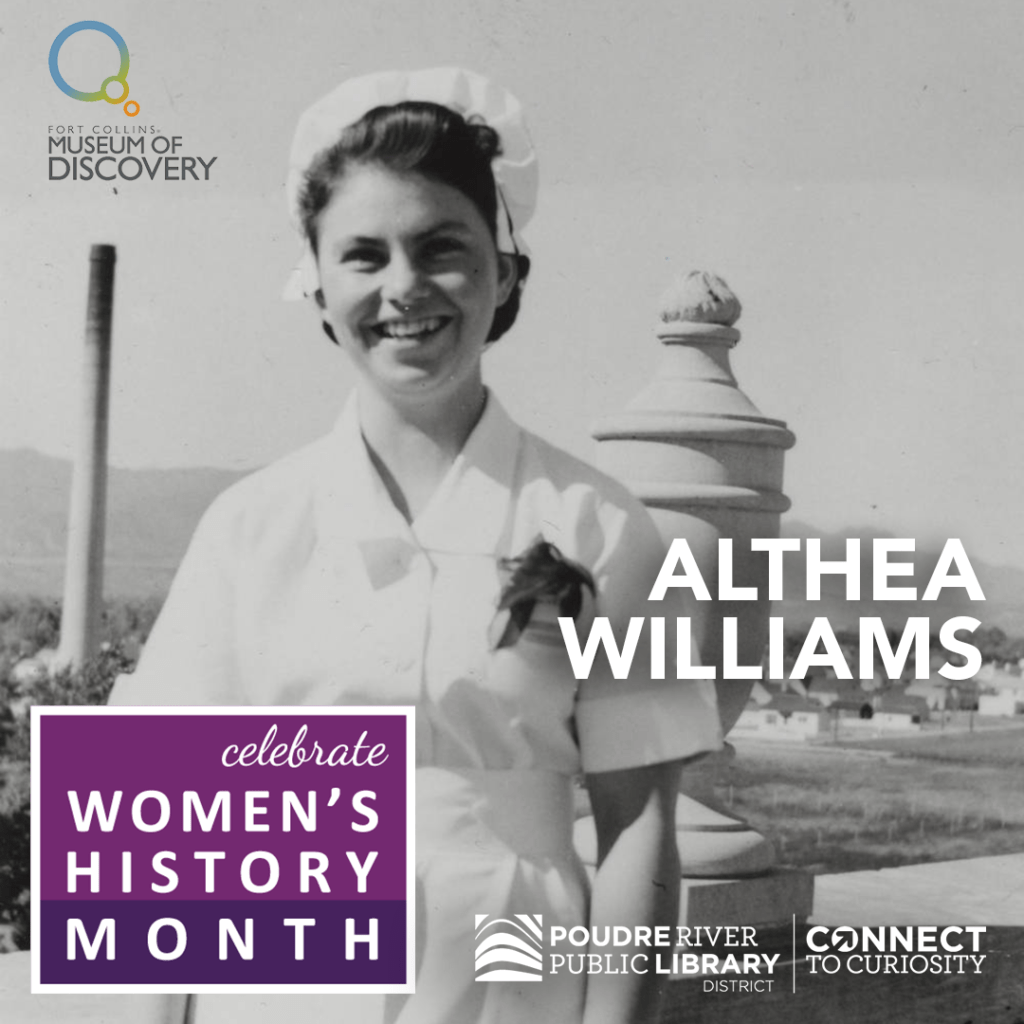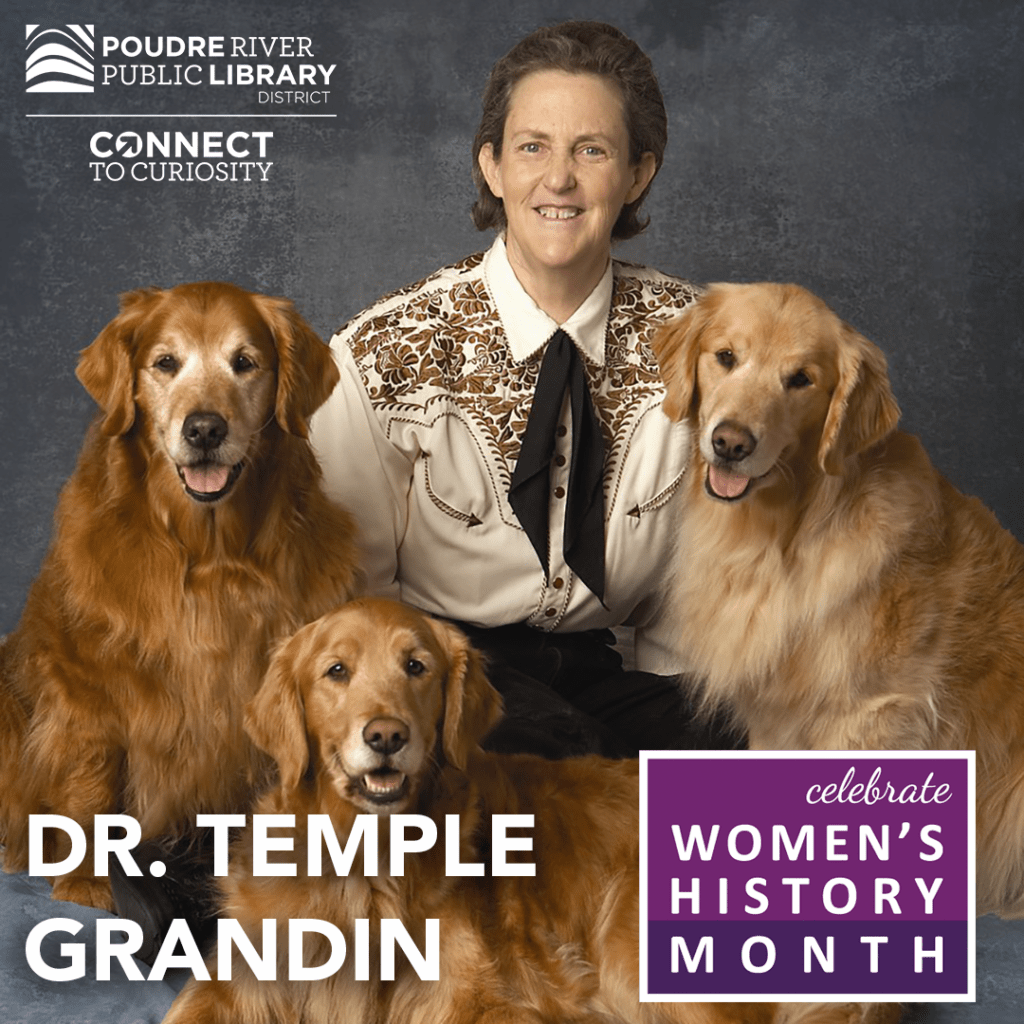A Local Exploration for Women’s History Month
Desplácese hacia abajo para español

Women have shaped the Fort Collins we know today. This month, enjoy some book recommendations that accompany profiles on remarkable women in Northern Colorado history.
Our exciting mix of choices ranges from literature these women wrote themselves, to films and movies that align with the women’s life’s work. All historical photographs are sourced from Fort Collins History Connection, a collaboration between Fort Collins Museum of Discovery and Poudre Libraries.
Elfreda Stebbins
Over a century ago, Fort Collin’s very first Librarian, Elfreda Stebbins built a foundation upon which our district relies today. After graduating high school in Nebraska, Elfreda taught high school for two years before visiting a cousin who worked as a librarian in Cleveland, Ohio.
This trip would shape the rest of Elfreda’s life – she went on to attend Library school, and after graduating at age 26, she landed a job as the first City Librarian in Fort Collins at the newly opened Carnegie Library. At this time, the Library had a circulating collection of 2,700 books! Our collection today surpasses over 1 million items!
She served as the City’s Librarian from 1903 to 1931. During these three decades, she provided boundless enrichment to the Fort Collins community. After she passed away suddenly in 1931, the Colorado Association of Libraries honored her life and boundless energy stating, “her influence towards purposeful reading in [the] city was so great that she was named ‘the most important woman citizen Fort Collins ever had.'”
One of her reading suggestions during her tenure was So Big by Edna Ferber.
Elizabeth Stone
Meet one of the founding figures of Fort Collins often called its “Founding Mother” – Elizabeth “Auntie” Stone. Born in 1801, Stone’s early years were spent as a pioneer moving across the west. She eventually found her way to Fort Collins in 1860 at age 63 to run an officer’s mess hall with her second husband, Judge Stone.
Her husband passed away just six years after the couple arrived in Fort Collins. At this time, Auntie Stone assumed ownership of the mess hall and made it into a public hotel. Eventually, her house evolved into the city’s first hospital and school. Stone was integral to the formation of Fort Collins as we know it today and was responsible for starting the city’s first mill and brick kiln.
She was also a fierce supporter of women’s suffrage and voted for the first time at the age of 93 in a municipal election saying, “I have waited a lifetime for this privilege.” She would pass away just a year later – every business in town halted operations and the town bell rang 94 times to honor each year of her long and accomplished life.
You can visit Auntie Stone’s Cabin in Library Park where it sits today. To engage younger minds in the fantastic life of Elizabeth Stone, we recommend The Saga of Auntie Stone and her Cabin by Noley Mumie.
Jovita Vallencillo Lobato
One of Jovita Vallecillo Lobato’s personal philosophies was “Tie your wagon to a star. Otherwise, you might not get anywhere.” Jovita Vallencillo Lobato was born in Fort Collins in 1908 – her parents were sugar beet farmers and encouraged both of their children to attend public school and college.
Jovita is the first known Mexican-American to graduate from public school in Fort Collins (in 1932) and became the first Mexican-American student to graduate from CSU (in 1936) with degrees in economics and sociology. Undeterred by societal barriers, Jovita would go on to earn a master’s degree in psychology and teach in schools in Colorado, New Mexico, and New Jersey.
Sixty years after she graduated, she and her brother Salvador were honored at the CSU El Centro Achievement Awards. Over 1,000 Hispanic and Latinx students were enrolled at CSU that year, following in Jovita footsteps.
In honor of Jovita’s fields of study, we recommend Freakonomics by Steven D. Levitt & Stephen J. Dubner.
Charlene Tresner
Today, the Fort Collins History Connection provides a vital window into the past, including the stories from this piece and those we collected for Black History Month. The beginning of these archives is often accredited to the work of a woman named Charlene Tresner.
Born just outside of Fort Collins on a farm in 1918, Charlene attended school in Fort Collins through college at CSU. She later married and spent 20 years in Tulsa, Oklahoma teaching and raising her family before returning to Fort Collins.
After hearing of library efforts to archive history, Charlene secured grant funding to create a rich historical archive full of dozens of audio interviews. Charlene collected tens of thousands of photographs, storing them under her own bed until the archive room at the Library was ready. Thanks to Charlene’s work, we can honor important historical figures and events that made Fort Collins what it is today. Charlene wrote the book, The Streets of Fort Collins.
Margaret Martinez
Community builder, leader, and mother could all be words used to describe Margaret Martinez. Margaret was born in 1910 in New Mexico and would move to Northern Colorado when she was very young. She attended various Fort Collins schools and met her husband Charles Martinez in the Northern Colorado area. They married in 1927.
Margaret and Charles worked for the Great Western Sugar Company farming sugar beets for a decade across the state before they purchased their home from the company in 1937 in the Alta Vista neighborhood. Margaret and Charles took great pride in maintaining their home where they raised a large family.
The Martinez family would face the realities of their environment, the labor required to make a living, the discrimination towards Mexican-Americans in Fort Collins in the 1900s, and all the while, built a community with incredible longevity while doing it.
Long after the purchase of their home, their street, known formerly as “B Street,” was renamed “Martinez Street” in honor of Charles.
We suggest the film Los Betabeloros which honors Hispanic and Lantix beet workers in the United States like Margaret.
Sarah Ellis Eddy
It takes great courage to go against the grain of society, especially as a woman. Sarah Ellis Eddy was born in 1831 in New York, and 50 years later found her way to Greeley, Colorado to teach. Sarah often wore men’s clothing and an uncharacteristically short haircut for women in the late 1800s.
After teaching, Sarah purchased a book store downtown and amassed a fortune. She later sold her store and became involved in politics, serving as a delegate for a Fort Collins primary.
She died in 1921. Throughout her life, she broke barriers and built communities. Drawing on legacies of female business owners like Sarah, we recommend “Women in Business,” a show that explores stories of exceptional businesswomen. (Kanopy)
Agnes Wright Spring
Agnes Wright Spring is the only person in history (man or woman) to serve as the State Historian of two states – Colorado and Wyoming. Born in 1894, Agnes was a passionate writer, journalist, historian, and expert of Western history. Agnes was the first woman to graduate from the University of Wyoming with a degree in civil engineering. Despite her excellent grades, she was told there was little room for women in the field and later accepted a job as Assistant State Librarian in the Supreme Court Library in Cheyenne.
She married Archer T. Spring in 1921. The couple arrived in Fort Collins in 1922 and purchased a cherry orchard which unfortunately failed due to rough environmental conditions and the Great Depression. Wright served in many different positions through her life including Wyoming State Librarian, president of the Colorado Historical Society, and Colorado State Historian from 1954-1963. Agnes wrote over 20 books and 500 articles on the history of the West.
She took part in many Fort Collins community organizations and was awarded dozens of awards throughout her life. Agnes also took part in canvassing for women’s suffrage often finding people resistant to women at the ballot box even being told “I hope you never get the vote.”
We recommend Cavalry & Coaches : The Story of Camp and Fort Collins with the introduction written by Agnes Spring.
Dr. Nora Rice Miller
Dr. Nora Rice Miller came to Fort Collins in 1893 and taught 6th and 7th grade at the Franklin School. Shortly after coming to Fort Collins, she found herself widowed early in life with two children. Nora then decided to pursue her degree in medicine, eventually graduating from CU School of Medicine before the age of 35.
She began her practice in 1908 in Fort Collins and often traveled long distances via a horse-drawn buggy to care for her patients. It was exceedingly rare for a woman in this time to pursue medicine, making her one of the pioneers of women in the medical field.
Eventually, she moved to Baca County in Southern Colorado where she found more success in her practice which could be attributed to her being the only physician in the area. She would later move to Texas to practice and eventually took up her old profession of teaching during WWII in Montana to try and address the shortage of teachers.
To read up on women in medicine, dive into Bold Women of Medicine: 21 Stories of Astounding Discoveries, Daring Surgeries, and Healing Breakthroughs by Susan M. Latta.
Colonel Althea B. Williams
Another powerhouse woman from Fort Collins is Colonel Althea B. Williams. Althea’s family moved to Fort Collins in 1932 when she was 12. She attended school in the city and eventually received her degree from Beth-el College of Nursing in Colorado Springs.
Her first nursing job was at Larimer County Hospital. When Pearl Harbor occurred, she enlisted as an Army nurse. She served at four different stations in the Pacific during WWII and would return to Fort Collins after her deployment to pursue degrees in Home Economics and Occupational Therapy at CSU before reenlisting.
After rejoining the army, she went on to serve in the Korean War and the Vietnam War at which point she was promoted to Colonel and later, Chief Nurse. All the while, she saw combat medical treatment advance, noting the remarkable improvement over the course of three decades. In total, she served for 28 years and more than six deployments in the Army Nurse Corps.
When she retired in 1970, she was one of the highest-ranking women in the U.S. Army. She died in 2018 just before she turned 98 leaving behind a lifetime of compassionate service. In honor of her compassionate service, we suggest The Secret Rescue by Cate Lineberry which explores the care that nurses provided during WWII.
Dr. Temple Grandin
Beloved professor of Animal Science at CSU, Dr. Mary Temple Grandin is one of the most internationally recognizable women to live in Fort Collins. Her research in animal science ethics and cattle farming is world-renowned.
She is also one of the most prominent individuals in the world with Autism. She was one of the first adults in prominent public life to share she is autistic, which helped to break down the stigma and shame surrounding individuals with autism.
In 2010, she was named in Time Magazine as one of the most influential people in the world. She has published over 60 peer-reviewed academic papers in the field of animal science and helped to develop a system for assessing animal welfare at slaughterhouses. She has been inducted into the Colorado and National Women’s Hall of Fame.
We recommend Spectrum, a PBS series that explores the sensory experience of individuals with autism. The series is guided by Dr. Temple Grandin – she draws on her own experiences while breaking down the connections of sensory experience in the brain for individuals with autism. (Kanopy) Dr. Grandin also wrote the book, Thinking in Pictures which explores her life living with autism.
Historias de Asombrosas Mujeres en la Historia de Fort Collins
Mes De La Historia De La Mujer | 2022
Elfreda Stebbins
La primera bibliotecaria de Fort Collin, Elfreda Stebbins, construyó los cimientos sobre los que se basa nuestro distrito en la actualidad. Nacida en Michigan en 1877, Elfreda se graduó de la preparatoria en NE y luego dio clases por dos años antes de asistir a la escuela de bibliotecología.
Después de graduarse a los 26 años, consiguió un trabajo como la primera bibliotecaria de la ciudad en la recién inaugurada Biblioteca Carnegie. ¡En ese momento, la Biblioteca tenía una colección en circulación de 2,700 libros! ¡Hoy, nuestra colección supera 1 millón de artículos!
Elfreda se desempeñó como bibliotecaria de la ciudad de 1903 a 1931; durante tres décadas de servicio en la biblioteca, brindó un enriquecimiento ilimitado a la comunidad. Murió repentinamente en agosto de 1931 a la edad de 53 años en un viaje a una biblioteca en Western Slope de Colorado.
Elizabeth Stone
Conoce a una de las figuras fundadoras de Fort Collins, Elizabeth “Auntie” Stone. Nacida en 1801, los primeros años de Stone transcurrieron como pionera. Finalmente, se mudó a Fort Collins en 1860 para administrar un comedor de oficiales con su segundo esposo, el juez Stone.
Su esposo, el juez Stone, falleció 6 años después de que la pareja llegara a Fort Collins, momento en el que la tía Stone asumió la propiedad del comedor y lo convirtió en un hotel público. Stone fue parte integral de la formación del Fort Collins que conocemos hoy y fue responsable de iniciar el primer molino y horno de ladrillos para la prometedora ciudad.
Votó por primera vez a la edad de 93 años y dijo: “He esperado toda mi vida por este privilegio”. Ella fallecería solo un año después a la edad de 94 años. Puedes visitar la cabaña de la tía Stone en el parque Library Park, donde se encuentra hoy en día.
Jovita Vallencillo Lobato
Jovita Vallencillo Lobato nació en Fort Collins en 1908; sus padres eran agricultores de remolacha azucarera y animaron a sus dos hijos a asistir a la escuela pública y la universidad.
Jovita es la primera mexicana-americana graduada de una escuela pública en el área de Fort Collins en 1932 y se convirtió en la primera estudiante mexicana-americana en graduarse de CSU en 1936 con títulos en economía y sociología. Sin dejarse intimidar por las barreras sociales, Jovita obtuvo una maestría en psicología y enseñó en escuelas en CO, NM y NJ.
60 años después de graduarse, ella y su hermano Salvador fueron honrados en los premios CSU El Centro Achievement Awards. Más de 1000 estudiantes hispanos y latinos se inscribieron en CSU ese año, siguiendo los pasos de Jovita.
Charlene Tresner
Fort Collins History Connection ofrece hoy una ventana vital al pasado. El comienzo de estos archivos a menudo se atribuye al trabajo de una mujer llamada Charlene Tresner. Nacida en las afueras de Fort Collins en una granja en 1918, Charlene asistió a la escuela en Fort Collins hasta la universidad en CSU. Más tarde se casó y pasó 20 años en Tusla, OK enseñando y criando a su familia antes de regresar a Fort Collins.
Después de enterarse de los esfuerzos de la Biblioteca para archivar la historia, Charlene obtuvo subvenciones para crear un rico archivo histórico lleno de entrevistas en audio y miles de fotografías, e incluso escondió fotografías debajo de su cama hasta que la sala de archivos estuvo lista. Gracias al trabajo de Charlene, podemos honrar importantes figuras históricas y eventos que hicieron de Fort Collins lo que es hoy.
Margaret Martinez
Constructora comunitaria, líder y madre podrían ser palabras que se usan para describir a Margaret Martínez. Margaret nació en 1910 en Nuevo México y se mudó al norte de Colorado cuando era muy joven. Asistió a varias escuelas de Fort Collins y conoció a su esposo, Charles Martinez, en el área del norte de Colorado. Se casaron en 1927.
Después de casarse, Margaret y Charles trabajaron para Great Western Sugar Company cultivando remolacha azucarera durante diez años en varios lugares del estado antes de comprar su casa a la compañía en 1937 en el histórico vecindario de Alta Vista. El área fue construida originalmente por Great Western Sugar Company para albergar a los trabajadores y sus familias. Sin embargo, los Martinez hicieron del área una comunidad, trabajando para formar fuertes lazos entre las familias hispanas y latinas a través de la herencia, la tradición y el tiempo que pasan juntos.
Mucho después de la compra de su casa, su calle conocida anteriormente como “calle B” pasó a llamarse “calle Martínez” en honor a Charles.
Sarah Ellis Eddy
It takes great courage to go against the grain of society, especially as a woman. Sarah Ellis Eddy was born in 1831 in New York, and 50 years later found her way to Greeley, Colorado to teach. Sarah often wore men’s clothing and an uncharacteristically short haircut for women in the late 1800s.
After teaching, Sarah purchased a book store downtown and amassed a fortune. She later sold her store and became involved in politics, serving as a delegate for a Fort Collins primary.
She died in 1921. Throughout her life, she broke barriers and built communities. Drawing on legacies of female business owners like Sarah, we recommend “Women in Business,” a show that explores stories of exceptional businesswomen. (Kanopy)
Agnes Wright Spring
Agnes Wright Spring es la única persona en la historia (hombre o mujer) que se desempeñó como historiadora estatal de dos estados: Colorado y Wyoming. Nacida en 1894, Agnes fue una apasionada escritora, periodista, historiadora y experta en historia occidental. Agnes fue la primera mujer en graduarse de la Universidad de Wyoming con un título en ingeniería civil. A pesar de sus excelentes calificaciones, le dijeron que había poco lugar para las mujeres en el campo y luego aceptó un trabajo como Asistente de Bibliotecaria Estatal en la Biblioteca de la Corte Suprema en Cheyenne.
Se casó con Archer T. Spring en 1921; la pareja llegó a Fort Collins en 1922 y compró un huerto de cerezos que desafortunadamente fracasó debido a las duras condiciones ambientales y la Gran Depresión. Wright se desempeñó en muchos puestos diferentes a lo largo de su vida, incluido el de bibliotecaria estatal de Wyoming, presidenta de la Sociedad Histórica de Colorado e historiadora estatal de Colorado de 1954 a 1963. Agnes escribió más de 20 libros y 500 artículos sobre la historia de Occidente.
Participó en muchas organizaciones comunitarias de Fort Collins y recibió docenas de premios a lo largo de su vida. Agnes también participó en la promoción del sufragio femenino y a menudo encontró personas que se resistían a las mujeres en las urnas, incluso cuando les decían “Espero que nunca obtengas el voto”.
Dr. Nora Rice Miller
La Dra. Nora Rice Miller llegó a Fort Collins en 1893, donde enseñaría sexto y séptimo grado en la Escuela Franklin. Viuda a una edad temprana y con dos hijos, Nora decidió obtener su título en medicina y finalmente se graduó de la Facultad de Medicina de CU en Denver antes de los 35 años. Comenzó su práctica en 1908 en Fort Collins y, a menudo, viajaba largas distancias en carruajes tirados por caballos para cuidar a sus pacientes. Era extremadamente raro que una mujer en este momento se dedicara a la medicina, lo que la convirtió en una de las pioneras en el campo de la medicina.
Eventualmente se mudó al condado de Baca en el sur de Colorado, donde encontró más éxito en su práctica, lo que podría atribuirse a que era la única doctora en el área. Retomó su antigua profesión de enseñanza durante la Segunda Guerra Mundial en Montana para ayudar con el problema de escasez de maestros. Se retiró de la docencia en 1949.
Colonel Althea B. Williams
Otra mujer poderosa de Fort Collins es la coronel Althea B. Williams. La familia de Althea se mudó a Fort Collins en 1932 cuando ella tenía 12 años. Althea asistió a la escuela en Fort Collins y finalmente recibió su título de Beth-el College of Nursing.
Cuando ocurrió Pearl Harbor, se enlistó como enfermera del ejército. Sirvió durante la Segunda Guerra Mundial y luego obtuvo títulos en Economía Doméstica y Terapia Ocupacional en CSU antes de volver a enlistarse. Más tarde sirvió en las guerras de Corea y Vietnam y finalmente fue ascendida a coronel y enfermera jefe.
En total sirvió durante 28 años y más de 6 despliegues. Cuando se jubiló en 1970, era una de las mujeres de más alto rango en el Ejército de los Estados Unidos. Murió en 2018 justo antes de cumplir 98 años.
Dr. Temple Grandin
La querida profesora de Ciencias Animales en CSU, la Dra. Mary Temple Grandin es una de las mujeres más reconocidas internacionalmente que vive en Fort Collins.
También es una de las personas más destacadas del mundo con autismo. Fue una de las primeras figuras públicas en compartir abiertamente su condición, lo que ayudó a romper el estigma que rodea a las personas con autismo.
En 2010, la revista Time la nombró una de las personas más influyentes del mundo. En 2020, también fue nombrada una de las 10 mejores profesoras universitarias del país. Ha publicado más de 60 artículos académicos en el campo de la ciencia animal y ayudó a desarrollar un sistema para evaluar el bienestar animal en los mataderos. También ha sido incluida en el Salón de la Fama de Mujeres Nacionales y de Colorado, además de recibir muchos otros honores.

